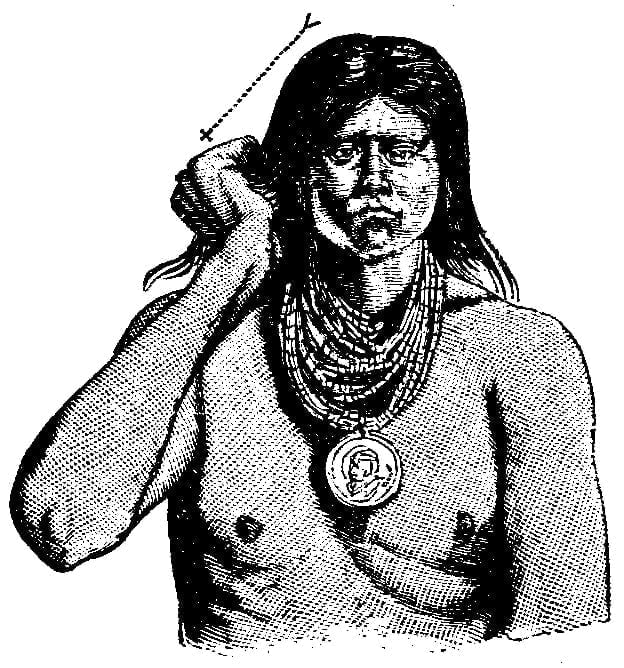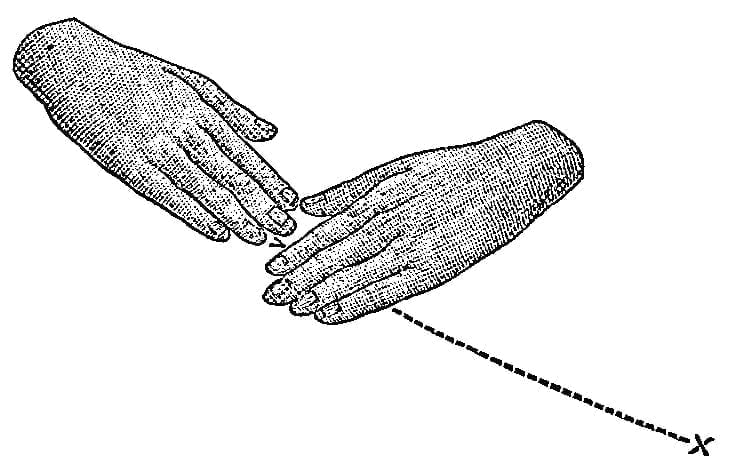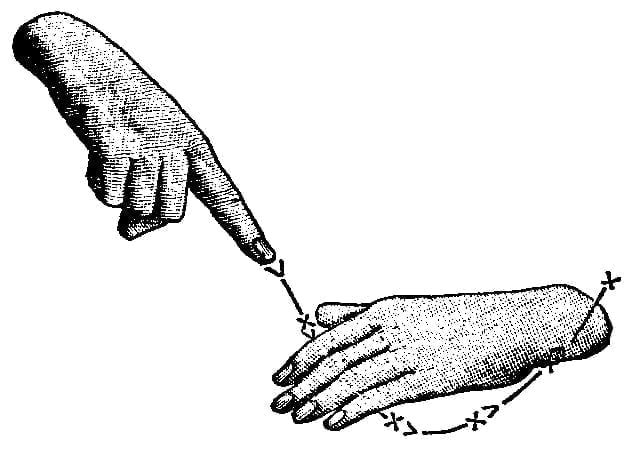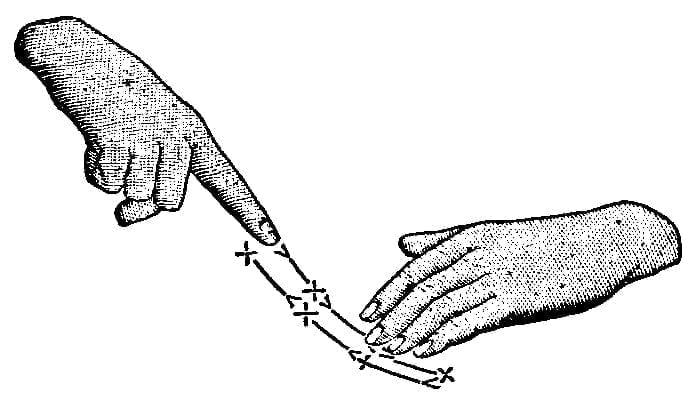Chief
The forefinger of the right hand extended, pass it perpendicularly downward, then turn it upward, and raise it in a right line as high as the head. (Long.) “Rising above others.”
Raise the index finger of the right hand, holding it straight upward, then turn it in a circle and bring it straight down, a little toward the earth. (Wied.) The right hand is raised, and in position (J) describes a semicircle as in beginning the act of throwing. The arm is elevated perfectly erect aside of the head, the palm of the index and hand should be outward. There is an evident similarity in both execution and conception of this sign and Wied‘s; the little variation may be the result of different interpretation. The idea of superiority is most prominent in both. (Boteler.) “A prominent one before whom all succumb.” The Arikaras understood this sign, and they afterwards used it in talking to me. (Creel.) Wied‘s air-picture reminds of the royal scepter with its sphere.
Raise the forefinger, pointed upwards, in a vertical direction, and then reverse both finger and motion; the greater the elevation the “bigger” the chief. (Arapaho I.)
Place the closed hand, with the index extended and pointing upward, near the right cheek, pass it upward as high as the head, then turn it forward and downward toward the ground, the movement terminating a little below the initial point. See Fig. 306 in Tendoy-Huerito Dialogue, p. 487. (Arapaho II; Cheyenne V; Ponka II; Shoshoni I.)
(1) Sign for Man, as follows: Right hand, palm inward, elevated to about the level of the breast, index carelessly pointing upward, suddenly pointed straight upward, and the whole hand moved a little forward, at the same time taking care to keep the back of the hand toward the person addressed; (2) middle, third, little finger, and thumb slightly closed together, forefinger pointing forward and downward; (3) curved motion made forward, outward, and downward. (Cheyenne II.) “He who stands still and commands,” as shown by similarity of signs to sit here or stand here.
Extend the index, remaining fingers closed, and raise it to the right side of the head and above it as far as the arm can reach. Have also seen the sign given by Wyandot I. (Ojibwa V.)
The extended forefinger of the right hand (J), of which the other fingers are closed, is raised to the right side of the head and above it as far as the arm can be extended, and then the hand is brought down in front of the body with the wrist bent, the back of hand in front and the extended forefinger pointing downward. (Dakota I.) “Raised above others.”
Move the upright and extended right index, palm forward, from the shoulder upward as high, as the top of the head, then forward six inches through a curve, and move it forward six inches, and then downward, its palm backward, to the height of the shoulder. An Arapaho sign, Above all others. He looks over or after us. (Dakota IV.)
Elevate the extended index before the shoulder, palm forward, pass it upward as high as the head, and forming a short curve to the front, then downward again slightly to the front to before the breast and about fifteen inches from it. (Dakota VI, VII, VIII; Hidatsa I; Arikara I.)
Right hand closed, forefinger pointing up, raise the hand from the waist in front of the body till it passes above the head. (Omaha I.)
Another: Bring the closed right hand, forefinger pointing up, on a level with the face; then bring the palm of the left hand with force against the right forefinger; next send up the right hand above the head, leaving the left as it is. (Omaha I.)
The right arm is extended by side of head, with the hand in position (J). The arm and hand then descend, the finger describing a semicircle with the arm as a radius. The sign stops with arm hanging at full length. (Oto I.) “The arm of authority before whom all must fall.”
Both hands elevated to a position in front of and as high as the shoulders, palms facing, fingers and thumbs spread and slightly curved; the hands are then drawn outward a short distance towards their respective sides and gently elevated as high as the top of the head. (Wyandot I.) “One who is elevated by others.”
Elevate the closed handindex only extended and pointing upwardto the front of the right side of the face or neck or shoulder; pass it quickly upward, and when as high as the top of the head, direct it forward and downward again toward the ground. (Kaiowa I; Comanche III; Apache II; Wichita II.) Close the right hand, index raised, extended, and placed before the breast, then move it forward from the mouth, pointing forward, until at arm’s length. (Ute I.)
– – , Head, of tribe.
Place the extended index, pointing upward, at some distance before the right shoulder, then place the left hand, with fingers and thumb extended and separated, just back of the index; then in passing the index upward as high as the head, draw the left hand downward a short distance, as in Fig. 244. Superior to others. (Absaroka I; Arikara I.)

Place both flat hands before the body, palms down, and pass them horizontally outward toward their respective sides, then make the sign for Chief. (Arikara I.) “Chief of the wide region and those upon it.”
After pointing out the man, point to the ground, all fingers closed except first (J 1, pointing downward in stead of upward), then point upward with same hand (J 2), then move hand to a point in front of body, fingers extended, palm downward (W 1), and move around horizontally. (Sahaptin I.) “In this place he is head over all.”
Grasp the forelock with the right hand, palm backward, pass the hand upward about six inches and hold it in that position a moment. (Pai-Ute I.) Fig 245.

Elevate the extended index vertically above and in front of the head, holding the left hand, forefinger pointing upward, from one to two feet below and underneath the right, the position of the left, either elevated or depressed, also denoting the relative position of the second individual to that of the chief. (Apache I.)
– – , War. Head of a war party; Partisan.
First make the sign of the pipe; then open the thumb and index finger of the right hand, back of the hand outward, moving it forward and upward in a curve. (Wied.) For remarks upon this sign see page 384.
Place the right hand, index only extended and pointing forward and upward, before the right side of the breast nearly at arm’s length, then place the left hand, palm forward with fingers spread and extended, midway between the breast and the right hand. (Arapaho II; Cheyenne V; Ponka II; Pani I.)
First make the sign for Battle, viz: Both hands (A 1) brought to the median line of the body on a level with the breast and close together; describe with both hands at the same time a series of circular movements of small circumference; and then add the sign for Chief, (Dakota I.) “First in battle.”
– – of a band.
Point toward the left and front with the extended forefinger of the left hand, palm down; then place the extended index about twelve inches behind the left hand, pointing in the same direction. (Arapaho II; Cheyenne V; Ponka II; Pani I.)
Place the extended index at some distance before the right shoulder, pointing forward and slightly upward, then place the left hand with fingers and thumb extended and separated over the index, and while pushing the index to the front, draw the left hand backward toward body and to the left. Ahead of others. (Absaroka I; Arikara I.) Fig. 246.

Point the extended index forward and upward before the chest, then place the spread fingers of the left hand around the index, but at a short distance behind it, all pointing the same direction. Ahead of the remainder. (Arikara I.)
Grasp the forelock with the right hand, palm backward, and pretend to lay the hair down over the right side of the head by passing the hand in that direction. (Pai-Ute I.) Fig. 247.

The French deaf-mute sign for order, command, maybe compared with several of the above signs. In it the index tip first touches the lower lip, then is raised above the head and brought down with violence. (L’enseignment primaire des sourds-muets; par M. Pélissier. Paris, 1856.)
Not only in Naples, but, according to De Jorio, in Italy generally the conception of authority in gesture is by pressing the right hand on the flank, accompanied by an erect and squared posture of the bust with the head slightly inclined to the right. The idea of substance is conveyed.
– – , Warrior lower than actual, but distinguished for bravery.
Place the left forefinger, pointing toward the left and front, before the left side of the chest, then place the extended index near (or against) the forefinger, and, while passing the latter outward toward the left, draw the index toward the right. (Absaroka I; Arikara I; Shoshoni I.) Fig. 248.

Dead, Death
Throw the forefinger from the perpendicular into a horizontal position toward the earth, with the back downward. (Long.)
Hold the left hand flat over the face, back outward, and pass with the similarly held right hand below the former, gently striking or touching it. (Wied.) The sign given (Oto and Missouri I) has no similarity in execution or conception with Wied’s. (Boteler.) This sign may convey the idea of under or burial, quite differently executed from most others reported. Dr. McChesney conjectures this sign to be that of wonder or surprise at hearing of a death, but not a distinct sign for the latter.
The finger of the right hand passed to the left hand and then cast down. (Macgowan.)
Hold the left hand slightly arched, palm down, fingers pointing toward the right about fifteen inches before the breast, then place the extended index nearer the breast, pointing toward the left, pass it quickly forward underneath the left hand and in an upward curve to termination. (Arapaho II; Cheyenne V; Ponka II; Pani I.)
Place the palm of the hand at a short distance from the side of the head, then withdrawing it gently in an oblique downward direction and inclining the head and upper part of the body in the same direction. (Ojibwa II.) See page 353 for remarks upon this sign.
Hold both hands open, with palms over ears, extend fingers back on brain, close eyes, and incline body a little forward and to right or left very low, and remain motionless a short time, pronouncing the word Ke-nee-boo slowly. (Ojibwa IV.)
Left hand flattened and held back upward, thumb inward in front of and a few inches from the breast. Right hand slightly clasped, forefinger more extended than the others, and passed suddenly under the left hand, the latter being at the same time gently moved toward the breast. (Cheyenne II.) “Gone under.”
Both hands horizontal in front of body, backs outward, index of each hand alone extended, the right index is passed under the left with a downward, outward and then upward and inward curved motion at the same time that the left is moved inward toward the body two or three inches, the movements being ended on the same level as begun. “Upset, keeled over.” For many deaths repeat the sign many times. The sign of (Cheyenne II) expresses “gone under,” but is not used in the sense of death, dead, but going under a cover, as entering a lodge, under a table, &c. (Dakota I.)
Make the sign for Alive, viz.: The right hand, back upward, is to be at the height of the elbow and forward, the index extended and pointing forward, the other fingers closed, thumb against middle finger; then, while rotating the hand outward, move it to a position about four inches in front of the face, the back looking forward and the index pointing upward; then the sign for No. (Dakota IV.)
Another: Hold the left hand pointing toward the right, palm obliquely downward and backward, about a foot in front of the lower part of the chest, and pass the right hand pointing toward the left, palm downward, from behind forward underneath it. Or from an upright position in front of the face, back forward, index extended and other fingers closed, carry the right hand downward and forward underneath the left and about four inches beyond it, gradually turning the right hand until its back is upward and its index points toward the left. An Arapaho sign. Gone under or buried. (Dakota IV.)
Hold the left hand slightly bent with the palm down, before the breast, then pass the extended right hand, pointing toward the left, forward under and beyond the left. (Dakota VI, VII.)
Hold the right hand, flat, palm downward, before the body; then throw it over on its back to the right, making a curve of about fifteen inches. (Dakota VI;Hidatsa I; Arikara I.) The gesture of reversal in this and other instances may be compared with picture-writings in which the reversed character for the name or totem of a person signifies his death. One of these is given in Fig. 249, taken from Schoolcraft’s Hist. Am. Tribes, I, p. 356, showing the cedar burial post oradjedatig of Wabojeeg, an Ojibwa war chief, who died on Lake Superior about 1793. He belonged to the deer clan of his tribe and the animal is drawn reversed on the post.

Extend right hand, palm down, hand curved. Turn the palm up in moving the hand down towards the earth. (Omaha I.)
The countenance is brought to a sleeping composure with the eyes closed. This countenance being gradually assumed, the head next falls toward either shoulder. The arms having been closed and crossed upon the chest with the hands in type positions (B B) are relaxed and drop simultaneously towards the ground, with the fall of the head. This attitude is maintained some seconds. (Oto and Missouri I.) “The bodily appearance at death.”
Place the open hand, back upward, fingers a little drawn together, at the height of the breast, pointing forward; then move it slowly forward and downward, turning it over at the same time. (Iroquois I.) “To express ‘gone into the earth, face upward.'”
The flat right hand is waved outward and downward toward the same side, the head being inclined in the same direction at the time, with eyes closed. (Wyandot I.)
Hold the left hand loosely extended about fifteen inches in front of the breast, palm down, then pass the index, pointing to the left, in a short curve downward, forward, and upward beneath the left palm. (Kaiowa I; Comanche III; Apache II; Wichita II.)
Bring the left hand to the left breast, hand half clinched (H), then bring the right hand to the left with the thumb and forefinger in such a position as if you were going to take a bit of string from the fingers of the left hand, and pull the right hand off in a horizontal line as if you were stretching a string out, extend the hand to the full length of the arm from you and let the index finger point outward at the conclusion of the sign. (Comanche I.) “Soul going to happy hunting-grounds.”
The left hand is held slightly arched, palm down, nearly at arm’s length before the breast; the right extended, flat, palm down, and pointing forward, is pushed from the top of the breast, straightforward, underneath, and beyond the left. (Shoshoni and Banak I.) Fig. 250.

Close both eyes, and after a moment throw the palm of the right hand from the face downward and outward toward the right side, the head being dropped in the same direction. (Ute I.)
Touch the breast with the extended and joined fingers of the right hand, then throw the hand, palm to the left, outward toward the right, leaning the head in that direction at the same time. (Apache I.)
Close the eyes with the tips of the index and second finger, respectively, then both hands are placed side by side, horizontally, palms downward, fingers extended and united; hands separated by slow horizontal movement to right and left. (Kutchin I.)
Palm of hand upward, then a wave-like motion toward the ground. (Zun̄i I.)
Deaf-mute natural signs:
Place the hand upon the cheek, and shut the eyes, and move the hand downward toward the ground. (Ballard.)
Let your head lie on the open hand with eyes shut. (Cross.)
Use the right shut hand as if to draw a screw down to fasten the lid to the coffin and keep the eyes upon the hand. (Hasenstab.)
Move the head toward the shoulder and then close the eyes. (Larson.)
Deaf mute signs:
The French deaf-mute conception is that of gently falling or sinking, the right index falling from the height of the right shoulder upon the left forefinger, toward which the head is inclined.
The deaf-mute sign commonly used in the United States is the same as Dakota VI; Hidatsa I; Arikara I; above. Italians with obvious conception, make the sign of the cross.
—— To Die.
Right hand, forefinger extended, side up, forming with the thumb a ‘U’; the other fingers slightly curved, touching each other, the little finger having its side toward the ground. Move the hand right and left then forward, several times; then turn it over suddenly, letting it fall toward the earth. (Ojibwa V; Omaha I.) “An animal wounded, but staggering a little before it falls and dies.”
—— Dying.
Hold the left hand as in dead; pass the index in the same manner underneath the left, but in a slow, gentle, interrupted movement. (Kaiowa I; ComancheIII; Apache II; Wichita II.) “Step by step; inch by inch.” Fig. 251.

—— Nearly, but recovers.
Hold the left hand as in dead; pass the index with a slow, easy, interrupted movement downward, under the left palm, as in dying, but before passing from under the palm on the opposite side return the index in the same manner to point of starting; then elevate it. (Kaiowa I; Comanche III;Apache II; Wichita II.) Fig. 252.

Other remarks upon the signs for dead are given on page 353.
